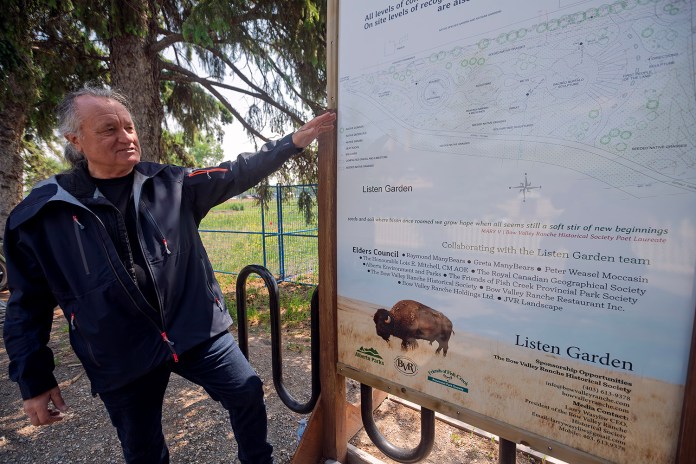Visitors to the historic Bow Valley Ranche at Fish Creek Park will be seeing a major change over the next several years, as land transformation becomes real reconciliation towards 2027.
The park’s new Listen Garden, which broke ground in May, was designed to be a reflection of the lessons taught by Indigenous elders, in an apolitical form that invites anyone to come and learn.
Bow Valley Ranche Historical Society President Larry Wasyliw, said that like the name for the garden, the purpose was to help people open themselves to listening, collaborating, and discussing.
“Everybody has a spirit, everybody has a belief, and their beliefs like anyone else go back to the Creator. So, everything that we’re representing here is learning the first thing, listening, open your ears, look what’s going on, and get a feeling,” he said.
“My motto is heal the land, heal the man. So, we’re working with the ecology, working with nature in a process to develop something really unique.”
As part of the development of the garden, native grasses and plants are planned to be returned to the area as both a representation of reconciliation, but also as part of a broader movement towards ecological restoration occurring in Fish Creek Park.
Wasyliw said the genesis for the Listen Garden began with then-Lieutenant Governor of Alberta, Lois Mitchell.
“She brought me a little sheet of paper that said seeds for change, and it was a reflection of the Royal Canadian Geographic Society’s work they did on reconciliation. I read this, and I said ‘wow, that’s really interesting let me look at this stuff.’ But I said to Lois, ‘I’m so busy.’ She says, ‘Larry, you’re going to do this… listen, Larry, when the Queen asks you just say yes,’” he said.
“Five years later, here we are.”
 Larry Wasyliw, President of the Bow Valley Ranche Historical Society, points to the features in the new Listen Garden at Fish Creek Park in Calgary on Saturday, June 7, 2025. ARYN TOOMBS / FOR LIVEWIRE CALGARY
Larry Wasyliw, President of the Bow Valley Ranche Historical Society, points to the features in the new Listen Garden at Fish Creek Park in Calgary on Saturday, June 7, 2025. ARYN TOOMBS / FOR LIVEWIRE CALGARY
Indigenous ways of knowing built into design of garden
That direction from Mitchell began a process that examined how reconciliation could be created within a garden setting.
Wasyliw said that after extensive discussions and conversations with Treaty 7 partners, it was decided that the garden would be a spiritual place with a spiritual focus.
He said that the spiritual journey begins each time with the movement from West to East through the garden and past a statue that reflects both the directions of the compass but also the different Indigenous colours.
That leads past a sunburst design pathway into the first circle and the garden’s sacred buffalo sculpture.
“The buffalo has a serious cultural significance, so this is part of the male circle, and we’ll have three buffaloes. They’ll be life-size, male, female, and [calf], and they’ll be the centre focal in this centre circle,” said Wasyliw.
That leads through the Métis connection path, designed like the infinity sign used on the Métis flag, into the female circle, which will represent learning.
Wasyliw said that would have a sound sculpted representation as its focus statue.
“Then you move into a third circle, which is a gathering circle. So, there will be a tipi here, and a representation of what you learn as you came from the west and you went through this process. If you didn’t learn anything, maybe you need to go back and start all over again,” he said.
“As we move to the west side, this ends up being the full circle, and that’s what this represents: the future with kids. So, if you take a look at that piece right now, you’ll see feathers and an eagle facing west.”
He said that school groups coming to the garden will then have their students invited to paint on a rock, which will then be added permanently to the garden’s collection.
“They’ll represent their own creativity, and they’ll leave it there; it’ll be part of the future. So, when they come back in 20 years, or a day, or whatever, they always will say ‘that’s my rock,’” Wasyliw said.
“This is going to be a very strategic, impactful way to get people together… getting different nations to tell their story, whether it’s language or culture, drumming or music, and getting them involved with no borders.”
Liked it? Take a second to support Aryn Toombs on Patreon!


